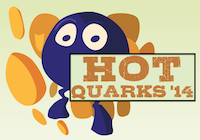Speaker
Kefeng Xin
Description
In ultrarelativistic heavy-ion collisions with high particle multiplicities, a muon can be bound to a charged hadron by Coulomb force and form a hydrogen-like atom. Among these atoms, the antimatter muonic hydrogen ($\bar{p}-\mu$) and the $K-\mu$ atom have been predicted but not yet been discovered[1]. At the STAR experiment, muon identification at low transverse momentum provides a great opportunity to search for a variety of muonic atoms. Because only thermal muons or muons from short-lived resonance decays are capable of forming muonic atoms, they can be used as an ideal tool, as suggested by M. Schwartz, J. Sandweiss and the authors of [1,2], to determine the thermal emission from the Quark-Gluon Plasma via a direct measurement of the single muon spectrum. We will present our results on the $\sqrt{s_{NN}}=200$ GeV Au+Au collisions collected by the STAR experiment at RHIC. We will show the possible signatures of the new muonic atoms extracted from invariant mass distributions and also from particle correlations.
[1] Joseph Kapusta and Agnes Mocsy, Phys. Rev. C 59, 5, (1999).
[2] Gordon Baym, Gerald Friedman, R. J. Hughes and Barbara V. Jacak, Phys. Rev. D 49, 4 (1993).
Author
Kefeng Xin
